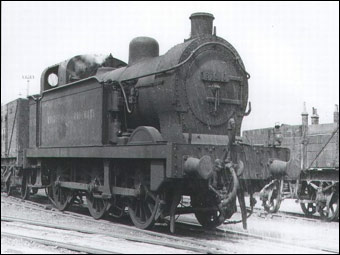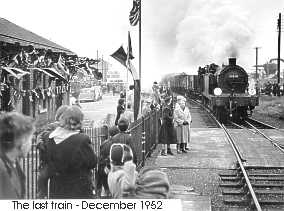
Locomotive R1 0-6-0T no 31010 on 21st April 1951

The last train in December 1952.
 Locomotive R1 0-6-0T no 31010 on 21st April 1951 |
 The last train in December 1952. |
By 1836 the 'Invicta' was replaced and a third winding engine was built at South Street. The line was a pioneer in railway engineering using embankments, cuttings, level crossings, bridges and an 836 yard (764 metres) tunnel through the high ground at Tyler Hill.
After the First World War, bus competition began to cause problems, although the line got a new lease of life in the 1920's as a popular holiday day-trip line, especially at weekends, when it became known as the "Crab & Winkle Line". Outside holiday periods, the line relied on freight.
However, the road infrastucture continued to improve and the line to Whitstable finally closed to passengers. When the last passenger train ran on 1st January 1931, it comprised locomotive R1 0-6-0T No. 31010 (photographed (above, left) in Whitstable Harbour, 21st April 1951) hauling two brake vans to Whitstable with passengers, including press and radio representatives. Whitstable Harbour station had been decorated for the occasion and the train was met by a crowd of about 100 people.
On the return journey the train stopped at the Canterbury end of the Tyler Hill Tunnel where a wreath was presented. (Because the tunnel had a limited bore, coaches were limited by size and the locomotive had a cut down chimney).
After 1930 the line was used for goods only and, under the ownership of British Rail, the line closed entirely in 1952. It re-opened for several weeks in 1953, after the great floods cut the main coastal line on 31 January. Despite many people's opinions, the line was not a Dr. Beeching victim. Like many similar provincial lines, it probably held on longer than it would normally have done as a result of temporary post-war need. The line was offered for sale in the late 1950s.
Please feel free to contact me by e-mail at elliottsimpson@hotmail.com
August 2006